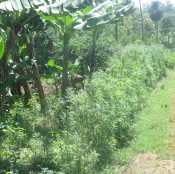California Hunting Agriculture, Forestry Emissions Reductions
California has adopted bold greenhouse gas reduction goals, and state regulators see emission reductions from carbon offset projects, including from agriculture and forestry projects, as a vital factor in achieving these goals. But bringing more of these types of projects into the state’s regulated carbon market is challenging because of the high costs involved.

23 April 2014 | California has adopted ambitious – some would argue too ambitious – goals for reducing its greenhouse gas (GHG) emissions. It needs emission reductions from carbon offset projects to get there without putting too much of a financial strain on businesses regulated in the state, according to regulators.
In 2006, then-California Governor Arnold Schwarzenegger signed into law Assembly Bill 32 (AB 32) – a landmark piece of legislation that outlined the state’s efforts to reduce climate change. The legislation featured targets for reducing California’s GHG emissions to 1990 levels by 2020 and 80% below 1990 levels by 2050.
One of the ways the state chose to pursue its 2020 target was to adopt a carbon trading program that allows emissions reductions from projects in unregulated sectors such as agriculture and forestry. State regulators see these carbon offsets as a vital element of the program because the price of carbon in the state could double by 2020 without them, said Rajinder Sahota, Chief of the Climate Change Program Evaluation Branch of the California Air Resources Board, the agency overseeing AB 32 implementation.
California’s cap-and-trade program already welcomes carbon offsets generated from livestock, forestry and urban forestry projects. But market participants see opportunities for more land-based offsets – emissions reductions generated via agriculture and forestry projects – to be added to the system, including avoided grassland conversion, wetland restoration, composting, rangelands and rice cultivation projects.
“Needless to say this is an interesting time for carbon markets and land-based offsets,” Belinda Morris, Program Officer, Climate and Land Use Subprogram, The Packard Foundation, said at the Navigating the American Carbon World conference in San Francisco last month.
For a more in-depth look at potential land-based carbon offsets that could be included in California’s cap-and-trade program, please visit the Forest Carbon Portal.
Please see our Reprint Guidelines for details on republishing our articles.

